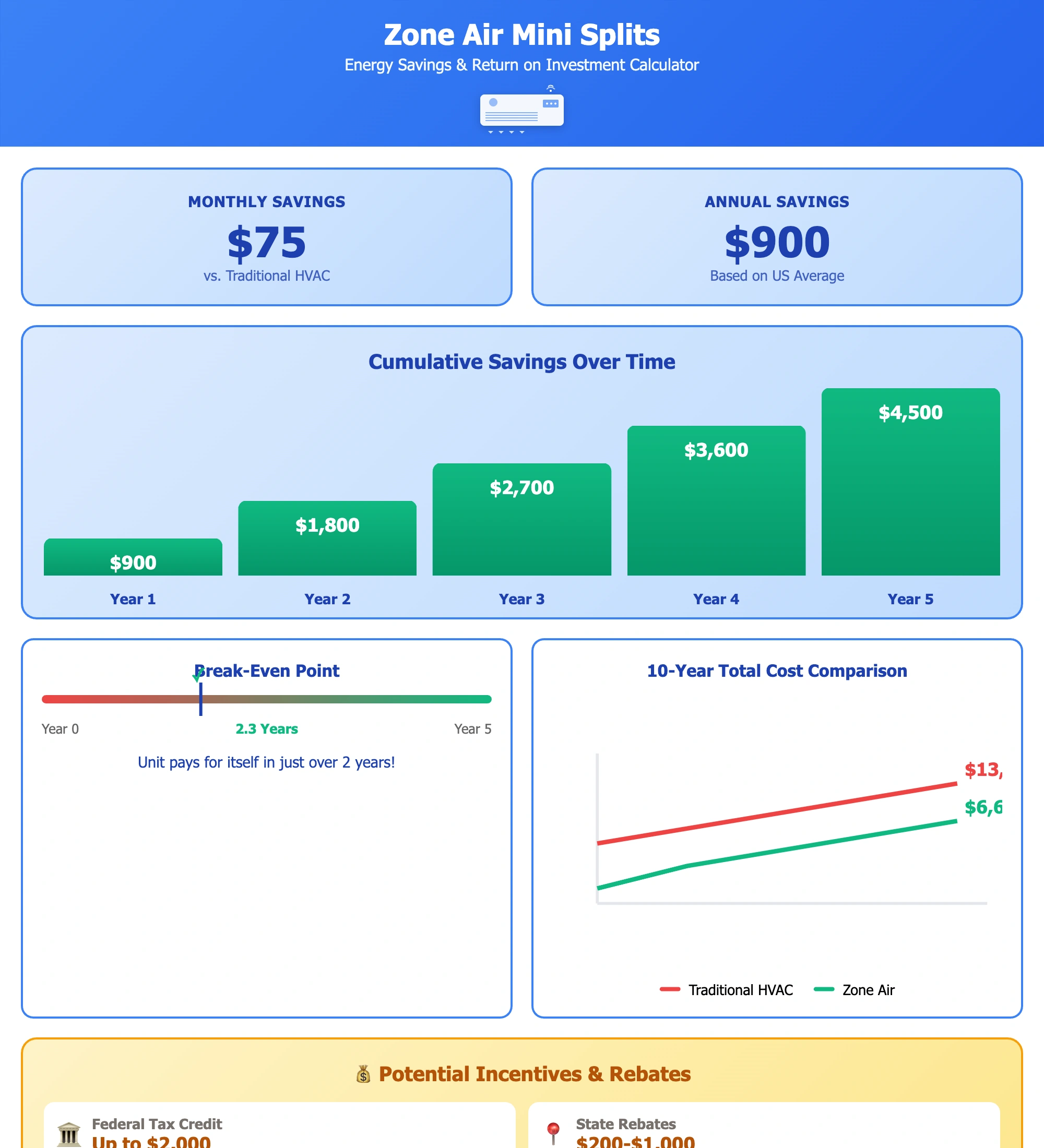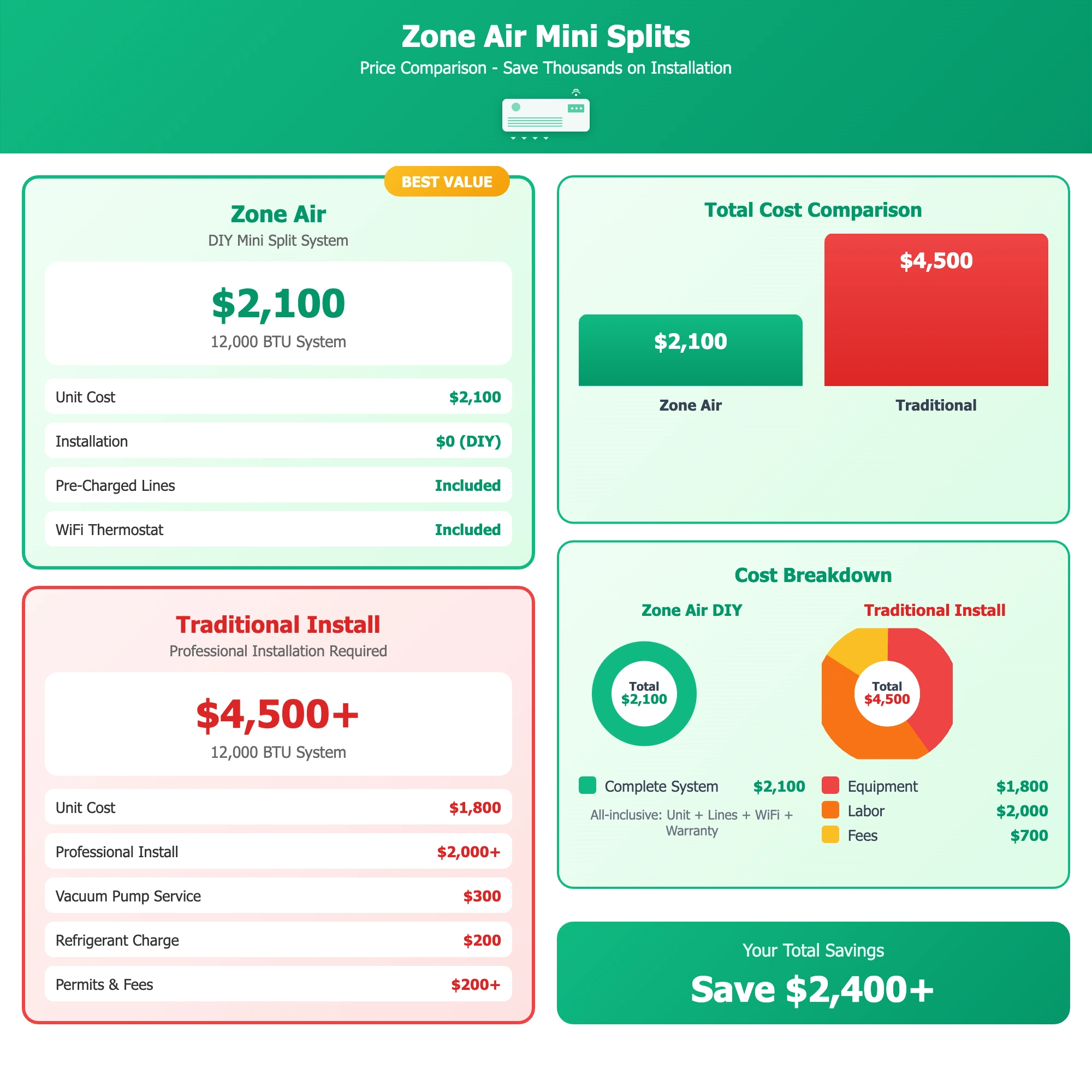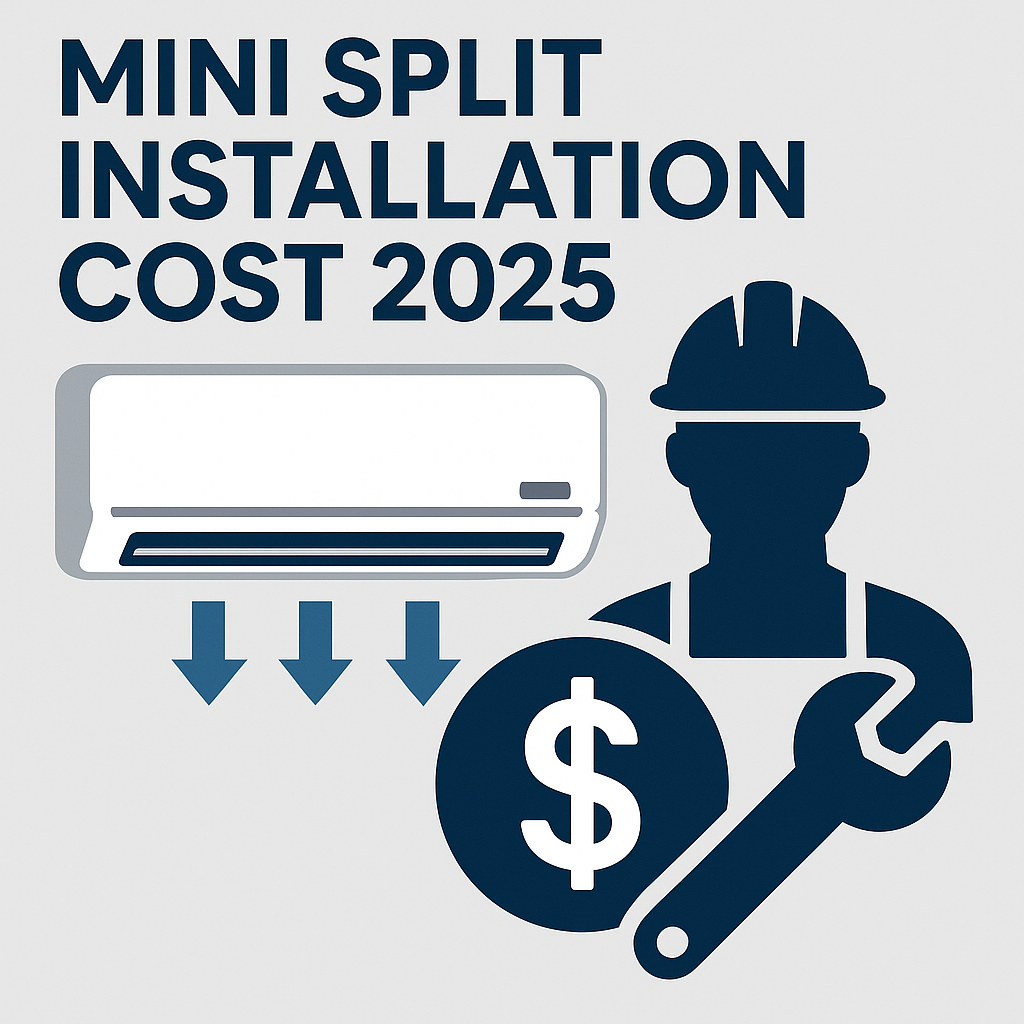Three contractors quoted the same room: $4,800, $7,200, and $5,500. None could explain why. After discovering DIY mini-splits, Kevin installed a better system himself for $2,400—half the lowest quote.
Here's exactly what mini-split installation costs in 2025, with zero BS.
Mini Split Installation Cost 2025 (Quick Answer)
| Installation Type | Equipment | Labor | Total Cost | |-------------------|-----------|-------|------------| | Single-Zone DIY | $1,500-$3,000 | $0 | $2,000-$3,500 | | Single-Zone Professional | $1,500-$3,000 | $1,500-$3,000 | $3,500-$6,800 | | Multi-Zone DIY | $3,000-$6,000 | $0 | $3,500-$7,500 | | Multi-Zone Professional | $3,000-$6,000 | $3,000-$6,000 | $6,000-$14,500 |
Cost per square foot: $3-$7 (DIY) or $7-$15 (professional)
💡 Interactive Tools: Price Comparison Tool | Savings Calculator
Real Examples: What People Actually Paid
Jessica (Portland) - Single-Zone DIY: $2,339 total (Zone 12K BTU). Installed herself in 6 hours. Saved $2,600 vs professional quotes.
Mike (Dallas) - Dual-Zone Professional: $8,450 total (24K BTU outdoor, 12K+18K indoor heads). Valued professional warranty, didn't want to deal with electrical work.
Johnsons (Phoenix) - 4-Zone Whole-Home: $13,800 total (premium Mitsubishi, 48K BTU). Bills dropped from $340/month to $180/month. ROI in under 2 years.
Equipment Costs by Size
Single-Zone Systems
| BTU | Room Size | Budget | Mid-Range | Premium | Zone DIY | |-----|-----------|--------|-----------|---------|----------| | 9K | Up to 450 sq ft | $800-$1,200 | $1,200-$1,800 | $1,800-$2,500 | $1,999 | | 12K | Up to 600 sq ft | $1,000-$1,500 | $1,500-$2,200 | $2,200-$3,000 | $2,189 | | 18K | Up to 850 sq ft | $1,400-$2,000 | $2,000-$2,800 | $2,800-$3,800 | $2,799 |
Multi-Zone Systems
| Zones | Total BTU | Budget | Mid-Range | Premium | Zone DIY | |-------|-----------|--------|-----------|---------|----------| | 2-Zone | 24K | $2,500-$3,500 | $3,500-$5,000 | $5,000-$7,000 | $3,499 | | 3-Zone | 36K | $3,500-$4,500 | $4,500-$6,500 | $6,500-$9,000 | $4,999 |
Professional Installation Labor Costs
Labor rates: $75-$150/hour (varies by region)
| System | Labor Cost | Install Time | What's Included | |--------|------------|--------------|-----------------| | Single-Zone | $1,500-$3,000 | 4-8 hours | Mount units, run lines, electrical, testing, warranty registration | | Multi-Zone | $3,000-$6,000 | 8-16 hours | All above + multiple indoor units | | Additional Zone | $500-$1,000/zone | +2-4 hours | Each zone added |
Regional Price Differences
- Highest costs: CA, NY, MA ($2,500-$4,000 single-zone)
- Lowest costs: Midwest, South ($1,500-$2,500 single-zone)
- Urban areas: +20-40% over national average
- Rural areas: Often add $100-$200 travel fees
Additional Costs to Budget For
Equipment Add-Ons
- Lineset extensions: $200-$500 (if standard length isn't enough)
- Mounting brackets: $100-$300
- WiFi thermostat: $100-$250
- Decorative line covers: $50-$200
- Condensate pump: $150-$300
Electrical Work
- New 115V circuit: $150-$300
- New 208-230V circuit: $300-$600
- Panel upgrade (if needed): $800-$2,500
- Disconnect box: $75-$150
Permits & Inspections
- Building permit: $50-$200 (sometimes free for DIY)
- Inspection: $50-$150
- HOA fees/requirements: $0-$500
Potential Hidden Costs
- Wall patching/repairs: $100-$300
- Manual J load calculation: $150-$300
- Extra refrigerant: $100-$300 (rare with quality install)
- Drain line work: $100-$400
DIY Installation: Save $1,500-$6,000
Savings:
- Single-zone: Save $1,500-$3,000
- Multi-zone: Save $3,000-$6,000
Tools needed (if you don't own): $120-$350 total
- Basic hand tools: $50-$150
- Level: $20-$50
- Drill/driver: $50-$150
Time investment:
- Single-zone: 4-8 hours
- Multi-zone: 8-16 hours
- First-timer? Add 2-4 hours for learning
Zone DIY Advantage: Pre-charged linesets eliminate $650-$2,350 in specialized tools (vacuum pump, gauges, refrigerant, EPA certification).
Monthly Operating Costs
| System | Efficiency | Monthly Cost | Annual Savings (vs Budget) | |--------|-----------|--------------|---------------------------| | Budget 12K (18 SEER) | 18 SEER | $45-$65 | Baseline | | Zone 12K (24 SEER2) | 24 SEER2 | $30-$45 | $180-$240/year | | Budget Dual (18 SEER) | 18 SEER | $75-$110 | Baseline | | Zone Dual (22 SEER2) | 22 SEER2 | $55-$80 | $240-$360/year |
Maintenance: DIY filter cleaning (free) or professional service ($100-$200/year)
Mini-Split vs Central Air Cost Comparison
| Cost Factor | Mini-Split (Single Zone) | Central Air | |-------------|-------------------------|-------------| | Equipment | $1,500-$3,000 | $3,000-$6,000 | | Labor | $1,500-$3,000 (or $0 DIY) | $2,000-$4,000 | | Ductwork | $0 (none needed) | $0 (if exists) or $5,000-$15,000 (new) | | Electrical | $200-$600 | $300-$800 | | Permits | $50-$200 | $100-$300 | | Total | $3,250-$6,800 (or $2,000 DIY) | $5,400-$11,100 (or $10,400-$26,100 with new ducts) | | Monthly Bills | $30-$50 | $100-$150 |
Bottom line: Mini-splits cost less upfront (if no ducts exist) AND 30-40% less to operate.

15-Year Total Cost Comparison
| System | Zone DIY | Professional Mini-Split | Central AC | |--------|----------|------------------------|------------| | Equipment & Install | $2,339 | $5,000 | $9,500 | | Electricity (15 yrs) | $8,100 | $11,700 | $14,400 | | Maintenance | $1,500 | $2,000 | $2,500 | | Total | $11,939 | $18,700 | $26,400 |
You save: $6,761 (vs pro mini-split) or $14,461 (vs central air) over 15 years with Zone DIY.
Rebates & Tax Credits (Stack These!)
- Federal tax credit: Up to $2,000 (Energy Star certified, SEER2 ≥16)
- Utility rebates: $200-$1,200 (Energy Star, cold climate, NEEP certified)
- State incentives: $500-$10,000 (varies by state - MA, CA, NY, VT offer most)
- Total potential savings: $500-$5,000+
Check DSIRE for your area's rebates.
Money-Saving Tips
- DIY installation: Save $1,500-$3,000
- Shop off-season: Save $200-$800 (fall/spring vs summer)
- Stack all rebates: Save $500-$5,000+
- Right-size your system: Don't overbuy capacity
- Strategic zones: Only install where you'll use them most

Why Choose Zone?
Direct-to-consumer pricing: No dealer markups. Zone 12K ($2,189) vs Mitsubishi ($5,000-$7,000) or Daikin ($4,500-$6,500). Save $2,300-$4,800.
What you get:
- 22-24 SEER2 efficiency
- Pre-charged linesets (no special tools needed)
- Complete DIY kits
- 5-year parts, 7-year compressor warranty
- 24/7 tech support
- Energy Star & NEEP certified
FAQ: Mini-Split Installation Cost
How much to DIY install a mini-split? $2,000-$5,500 total. Zone DIY systems eliminate $650-$2,350 in specialized tool costs. Install in 4-8 hours.
Cheapest way to install? DIY with pre-charged system. Save $1,500-$3,300 vs professional. Shop off-season for extra $200-$500 savings.
Worth paying for professional install? Only if: (1) Uncomfortable with heights, (2) Complex electrical, (3) 3+ zones, or (4) Code requires licensed contractor.
12K BTU cost installed? Professional: $3,500-$6,000. DIY: $2,000-$3,000. Zone DIY 12K: $2,189 (24 SEER2).
Mini-split vs central air cost? Central air: $6,900-$13,800 (with ducts) or $9,900-$20,800 (new ducts). Mini-split: $3,500-$6,800 (single-zone) or $6,000-$14,500 (multi-zone). Save $4,000-$8,000 if you need new ductwork.
Are mini-splits cheaper to run? Yes, 30-40% cheaper. Mini-split: $30-$45/month. Central air: $50-$70/month. Save $240-$300/year, or $3,600-$4,500 over 15 years.
Hidden costs? Panel upgrades ($800-$2,500), extended linesets ($200-$500), wall repairs ($100-$300), condensate pump ($150-$300), HOA requirements ($100-$500). Budget extra $300-$800.
Install time? DIY: 4-8 hours (single), 8-16 hours (multi). Professional: 1 day (1-2 zones), 2 days (3-5 zones).

Bottom Line: What You'll Actually Pay
Budget DIY: $2,000-$3,500 (one room, max savings) Mid-Range Professional: $4,000-$6,000 (1-2 zones, turnkey) Premium Whole-Home: $8,000-$14,500 (3-5 zones, replace entire HVAC)
Subtract $500-$5,000 in rebates/tax credits from these totals.
Next Steps:
- Free sizing calculator - Get your exact BTU needs
- Browse Zone systems - Premium DIY options
- Check rebates - Find incentives in your area
Related Guides: DIY Installation Guide | Sizing Guide | Mini-Split vs Central Air



